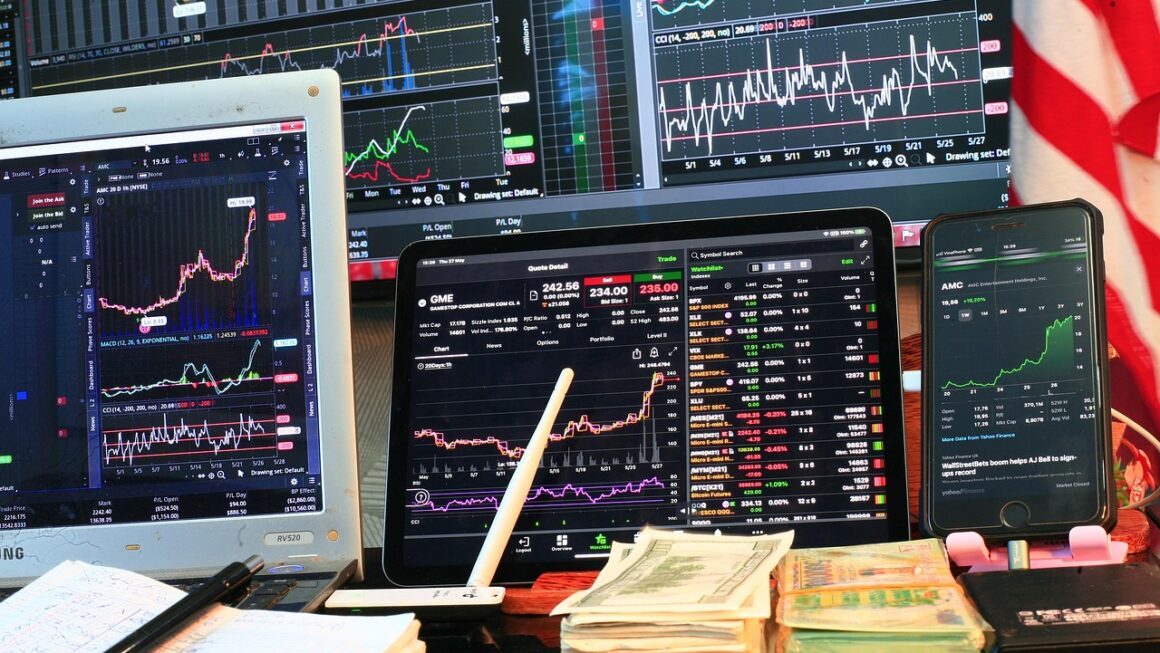Margin trading, a powerful tool in the hands of experienced investors, allows you to amplify your trading positions by borrowing funds from a broker. While it can potentially lead to larger profits, it also significantly increases the risk of substantial losses. This guide will delve into the intricacies of margin trading, exploring its mechanics, benefits, risks, and strategies for responsible usage.
What is Margin Trading?
The Basics Explained
Margin trading involves borrowing funds from a broker to increase your purchasing power. Instead of using only your own capital, you can control a larger position in the market. The amount you borrow is known as the margin, and the initial amount of your own funds required is called the initial margin.
- Definition: Leveraging borrowed funds to increase trading potential.
- Mechanism: Traders deposit a percentage of the total trade value (the margin) and borrow the remaining amount from the broker.
- Security: Your existing holdings typically serve as collateral for the borrowed funds.
Example Scenario
Imagine you want to buy 100 shares of a company trading at $100 per share, totaling $10,000. If you have a margin account with a 50% margin requirement, you only need to deposit $5,000 (50% of $10,000). The broker lends you the remaining $5,000. Your potential profit or loss is then calculated on the full $10,000 position. If the stock price increases to $110, your profit would be $1,000 (before interest and fees), representing a 20% return on your initial investment of $5,000. However, if the stock price drops to $90, your loss would be $1,000, a 20% loss on your initial investment.
Margin Requirements
Margin requirements are the percentage of the total investment that you must deposit with the broker. These requirements vary depending on:
- Asset type: Volatile assets typically have higher margin requirements.
- Broker: Different brokers set their own margin requirements, within regulatory limits.
- Account type: Certain account types may have different margin terms.
- Regulations: Regulators like FINRA (in the US) set minimum margin requirements for brokers.
Benefits of Margin Trading
Increased Potential Profits
The most significant benefit of margin trading is the ability to amplify profits. By controlling a larger position, even small price movements can result in substantial gains relative to your initial investment.
- Leverage: Allows traders to control larger positions with less capital.
- Profit Amplification: Potential for higher returns on investment compared to trading with cash only.
- Example: As shown earlier, a 10% price increase on a margin trade can yield a significantly higher return on the initial investment.
Portfolio Diversification
Margin trading can free up capital, allowing you to diversify your portfolio across multiple assets. By using margin to invest in one asset, you can use your remaining capital to explore other investment opportunities.
- Capital Efficiency: Reduces the amount of capital required for each investment.
- Opportunity Cost: Reduces the need to sell off other investments to fund new opportunities.
- Diversification: Allows you to spread risk across a wider range of assets.
Short Selling Opportunities
Margin accounts are often required for short selling, a strategy where you profit from a decline in an asset’s price. You borrow the asset, sell it, and then repurchase it later at a lower price, returning it to the lender. The difference between the selling price and the repurchase price is your profit.
- Access to Short Selling: Enables traders to profit from falling asset prices.
- Hedging: Can be used to hedge existing long positions against potential market downturns.
- Risk Management: Provides tools to mitigate downside risk in certain market conditions.
Risks of Margin Trading
Amplified Losses
While margin trading can magnify profits, it also magnifies losses. A small adverse price movement can quickly erode your initial investment, and you could lose more than your initial deposit.
- Leverage Works Both Ways: Losses are amplified just like profits.
- Potential for Substantial Losses: Traders can lose more than their initial investment.
- Emotional Discipline: Requires a strong emotional capacity and risk management strategy.
Margin Calls
A margin call occurs when the value of your account falls below the maintenance margin requirement (the minimum equity you must maintain in your margin account). When this happens, your broker will demand that you deposit additional funds or securities to bring your account back up to the required level.
- Definition: Demand from the broker to deposit more funds or securities.
- Cause: Occurs when the account equity falls below the maintenance margin requirement.
- Consequences: Failure to meet a margin call can lead to forced liquidation of your assets.
Interest Charges and Fees
Brokers charge interest on the borrowed funds used in margin trading. These interest charges can erode your profits and add to your overall trading costs. Additionally, there may be fees associated with opening or maintaining a margin account.
- Interest Rates: Brokers charge interest on the borrowed funds, which can vary based on market conditions and the broker’s terms.
- Compounding Effect: Interest charges can accumulate over time, reducing your overall returns.
- Transparency: It’s critical to understand the interest rates and fees associated with your margin account.
Strategies for Responsible Margin Trading
Thorough Research and Understanding
Before engaging in margin trading, it’s essential to thoroughly research and understand the assets you are trading. Analyze market trends, financial statements, and news events to make informed decisions.
- Due Diligence: Conduct thorough research on the assets you intend to trade.
- Fundamental Analysis: Understand the underlying factors driving the asset’s price.
- Technical Analysis: Use charts and indicators to identify potential trading opportunities.
Implement Stop-Loss Orders
Stop-loss orders are pre-set instructions to automatically sell an asset when it reaches a certain price. This can help limit your potential losses and prevent your account from falling below the maintenance margin requirement.
- Risk Mitigation: Stop-loss orders automatically sell an asset when it reaches a specified price.
- Emotional Control: Prevents emotional decision-making in volatile market conditions.
- Strategic Placement: Position your stop-loss orders based on your risk tolerance and market analysis.
Use Appropriate Leverage Levels
Avoid using excessive leverage, as it can significantly increase your risk of losses. Start with lower leverage levels and gradually increase them as you gain experience and confidence. Understand your risk tolerance and adjust leverage accordingly.
- Conservative Approach: Start with lower leverage levels and gradually increase as you become more experienced.
- Risk Tolerance: Adjust leverage based on your comfort level with potential losses.
- Avoid Over-Leveraging: Excessive leverage can lead to catastrophic losses.
Monitor Your Account Regularly
It’s crucial to monitor your margin account regularly to track your equity and ensure that you are meeting the maintenance margin requirements. Set up alerts to notify you when your account equity approaches the margin call level.
- Real-Time Tracking: Monitor your account balance, positions, and margin levels regularly.
- Alert Systems: Set up notifications to alert you of potential margin calls.
- Proactive Management: Take immediate action if your account approaches the maintenance margin requirement.
Conclusion
Margin trading can be a valuable tool for experienced traders seeking to amplify their returns. However, it’s crucial to understand the risks involved and to implement sound risk management strategies. By conducting thorough research, using stop-loss orders, employing appropriate leverage levels, and monitoring your account regularly, you can mitigate the risks and potentially benefit from margin trading. Remember that margin trading is not suitable for all investors, and it’s important to carefully consider your financial situation and risk tolerance before engaging in this type of trading.




